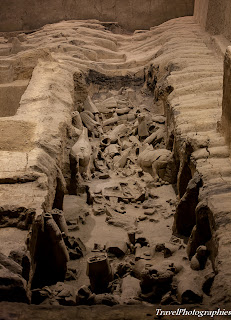China 2012: The terracotta army - pit #2
As written before, if you want to have a better feeling about the terracotta army exhibition place, start with this pit.
When you enter the building (which covers the pit), you are struck by the poor light and the wideness of the pit. You get excited like a child, even if there is nothing valuable to see at first sight.
I tried to take pictures. Because of the lack of light, it's not so easy. I was obliged to open at the max of the lens and choose the bigger ISO on my camera: 1600 !
Even, if I brought this day a 70-200mm L F/4.0, with a F/4 opening and 1600 ISO sensibility, the speed was very slow. Some of my pictures are out of focus.
You will have better results with a video recorder.
Anyway, please have a look on some pictures below.
Actually, the most of excavated (and shown to the public) terracotta warriors and horses from this pit are broken. The picture below was treated and enlightened a bit.
This one is the original one
Here are the main facts to remind about this pit (from travelchinaguide.com)
The Pit No.2 in Xian Qin Terra Cotta Warriors Museum is located 22 yards to the northeast of Terra Cotta Pit No.1. Covering an area of 7,176 square yards, Pit 2 is L-shaped, measuring 136 yards from east to west, 107 yards from north to south, and sixteen feet deep.
This excerpt talks about chariots, warriors and horses, but nothing much is actually shown to the public as this last picture illustrates.
When you enter the building (which covers the pit), you are struck by the poor light and the wideness of the pit. You get excited like a child, even if there is nothing valuable to see at first sight.
I tried to take pictures. Because of the lack of light, it's not so easy. I was obliged to open at the max of the lens and choose the bigger ISO on my camera: 1600 !
Even, if I brought this day a 70-200mm L F/4.0, with a F/4 opening and 1600 ISO sensibility, the speed was very slow. Some of my pictures are out of focus.
You will have better results with a video recorder.
Anyway, please have a look on some pictures below.
Actually, the most of excavated (and shown to the public) terracotta warriors and horses from this pit are broken. The picture below was treated and enlightened a bit.
This one is the original one
Here are the main facts to remind about this pit (from travelchinaguide.com)
The Pit No.2 in Xian Qin Terra Cotta Warriors Museum is located 22 yards to the northeast of Terra Cotta Pit No.1. Covering an area of 7,176 square yards, Pit 2 is L-shaped, measuring 136 yards from east to west, 107 yards from north to south, and sixteen feet deep.
Pit No.2 is the most spectacular of
the three pits. Compared to Pit No.1, the combat formations in Pit No.2
are more complex, and the units of armed forces are more complete.
According to preliminary calculations, there are over 80 war chariots,
about 1,300 terra cotta warriors and horses, and thousands of bronze
weapons. It is a revelation to first discover the terra cotta general,
the kneeling archer and the warrior with saddle horse in the pit. There
are two sloping entrances on the northern side, and four on both ends of
the eastern and western sides.
 The pit can be divided into four sections.
The pit can be divided into four sections.
Section 1:
Lying in the eastern corner of the pit, this section has a square
shape. There are four corridors around the four sides where 60
crossbowmen are in standing posture. In the center of the square, there
are four east-west passageways where 160 crossbowmen are aligned in
squatting position.
Section 2:
Lying in the right of the pit, section 2 measures 57 yards from east to
west and 52 yards from north to south. Sixty-four war chariots make up a
combat formation, which is divided into eight rows. Each of the
chariots is pulled by four life-sized terra-cotta horses. Three warriors
are side by side behind the chariot, with the middle one driving the
carriage and the others standing on either side.
Section 3:
In the center of the pit, is a rectangular combat formation made up of
264 foot soldiers and eight cavalrymen, as well as 19 war chariots.
There are three clusters. One cavalryman stands in front of a horse with
one hand drawing a bow and the other hand holding the rein.
Additionally, there are between eight and thirty-six foot soldiers
standing in each chariot.
Section 4:
In the left of the pit, there are three east-west passageways where all
the cavalrymen are aligned. The section measures 55 yards from east to
west and 25 yards from north to south. The four sections make up an
impregnable fortress. Next to the pit, there is a large exhibition hall
which has the most complete range of functions and is where visitors can
directly witness the excavation work in Pit 2.This excerpt talks about chariots, warriors and horses, but nothing much is actually shown to the public as this last picture illustrates.






Comments